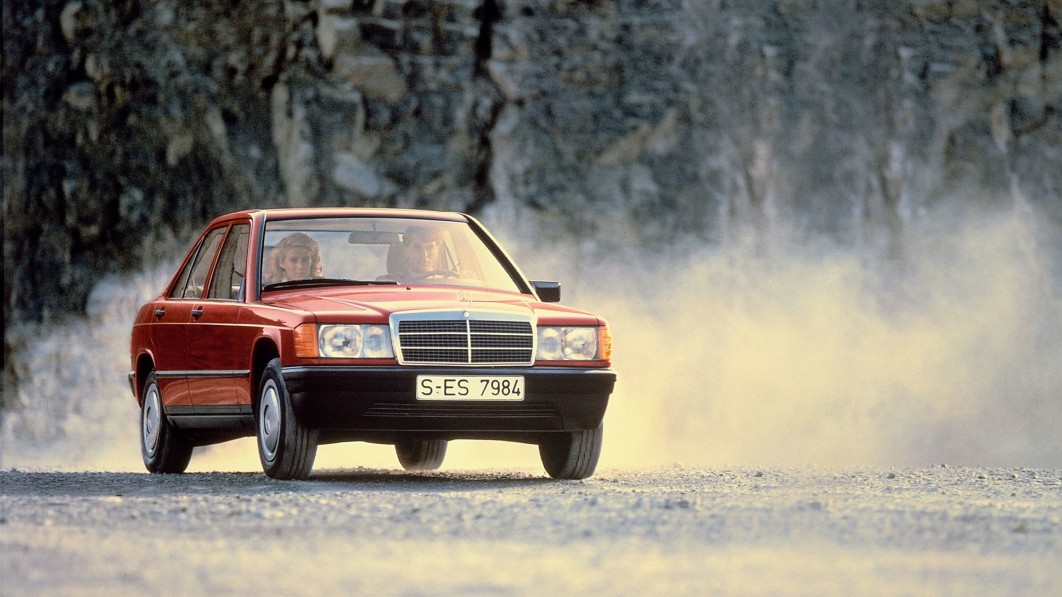
Mercedes-Benz’s lineup changed significantly in late 1982. By launching a new entry-level model called W201 internally and Baby Benz colloquially, the Stuttgart-based company made its cars accessible to a much wider audience and considerably increased its annual sales.
Although the first W201 saw the light that awaits at the end of a production line in December 1982, the idea of expanding the Mercedes range towards the bottom had ricocheted through the firm’s research and development department for many decades. In 1948, Mercedes developed a 145-inch long two-door sedan with a Ponton-like design. It didn’t reach production. Mercedes tried again in the 1950s: its board gave an entry-level model the green light in 1953, and several prototypes were built, but the project reached a dead end. It took several more tries (and pressure from regulators to improve the range’s average fuel economy rating) before the W201 became a reality.
In the early 1980s, the boxy W201 looked completely out of place parked next to a W126 and a W123 in a Mercedes showroom. And yet, in hindsight it blazed the path that later additions to the firm’s portfolio followed. The W124 released in late 1984 (and later turned into the first-generation E-Class) looked like a jumbo-sized W201, and this angular design language permeated the R129-generation SL as well as the W140 that ended its career as the first S-Class. Beauty is in the eye of the beholder; you could easily argue there’s absolutely nothing sexy about a W201 but you could just as easily argue it’s characterized by an elegant design that’s relatively simple, pure, and functional.
From the driver’s perspective, the W201 felt like the scaled-down Mercedes sedan that it was. The seats were developed with a focus on comfort, the instrument cluster was clearly legible, and most of the controls were grouped on the center stack. With that said, going from, say, a W123 to a W201 required picking up a new habit: the emergency brake was a lever located on the center console rather than a pedal.
In the United States, the W201 made its debut as a 1984 model with two available engines. The cheapest member of the range (which, in turn, became the most affordable Mercedes) was the 190E powered by a 2.3-liter four-cylinder engine rated at 113 horsepower and 133 pound-feet of torque, though those figures increased to 120 and 136, respectively, for 1985. Next up was the 190D, whose naturally-aspirated, 2.2-liter four-cylinder diesel engine developed 72 horsepower and 96 pound-feet of torque. Rear-wheel-drive and a five-speed manual transmission came standard regardless of fuel type, and buyers who didn’t want to shift could pay extra for a four-speed automatic.
Pricing started at $22,850 for the 190E and $22,930 for the 190D, figures that represent approximately $65,600 and $65,800 in 2022. In comparison, Volkswagen charged $6,530 (around $18,800 in 2022) for an entry-level Rabbit that year and a 2022 C-Class starts at $43,550.
The W201 was an instant hit, and its success encouraged Mercedes to launch additional variants in the 1980s. The 1986 model year brought a 16-valve, 167-horsepower evolution of the 2.3-liter four-cylinder and a 2.5-liter, 93-horsepower five-cylinder diesel. In 1987, the first six-cylinder-powered W201 landed in American showrooms as the 190E 2.6. It used the W124’s 158-horsepower straight-six. The range grew across the Atlantic as well, and Mercedes even took the W201 racing in a bid to dethrone the original, E30-based BMW M3.
Gasoline or diesel, four, five, or six cylinders, and automatic or manual; there were numerous ways to configure a W201. What never changed was the body style: throughout its career, the model was exclusively offered as a four-door sedan. Mercedes experimented with several different prototypes, including a pillar-less two-door convertible (shown in our gallery), but none were approved for production.
Most variants of the W201 carried the 190 nameplate (on its own to designate a carbureted engine, followed by an “E” to designate a fuel-injected gasoline engine, or followed by a “D” to designate a diesel engine) but there was one exception. In the early 1990s, Mercedes sold a stripped-down, entry-level variant of the W201 called 180E on the Australian market that was powered by a 1.8-liter four-cylinder engine.
W201 production ended in 1993 after about 1.87 million units were built. The sedan passed the torch to the original C-Class, which was called W202 internally and became the first compact Mercedes offered as a station wagon. While the 190 was considered a cheap, robust, and disposable car for many decades, it’s slowly but surely becoming sought-after by enthusiasts around the world and values are consequently increasing. Many were driven into the ground so finding a clean, well-kept example has become easier said than done.
